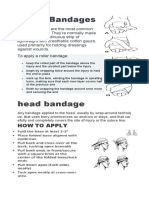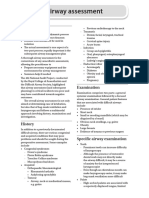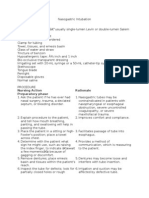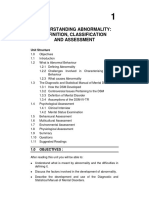Fetal Heart Tones
Uploaded by
Christian Clyde N. JakosalemFetal Heart Tones
Uploaded by
Christian Clyde N. JakosalemFETAL HEART TONES
CONDITION CAUSE GRADE
Fetal Tachycardia ❖ Infection ❖ Mild : > 5 BPM from baseline
❖ Dehydration ❖ Moderate: 6-25 BPM from baseline
❖ Fever ❖ Severe: < 25 BPM from baseline
❖ Fetal hypoxemia ❖ Absent : No fluctuation in fetal heart rate
❖ Anemia
❖ Prematurity
❖ Terbutaline
❖ Caffeine
❖ Epinephrine
❖ Theophylline
❖ illicit drugs
Fetal bradycardia ❖ Maternal hypotension ❖ Mild : > 5 BPM from baseline
❖ Supine hypotensive syndrome ❖ Moderate: 6-25 BPM from baseline
❖ Fetal decompression ❖ Severe: < 25 BPM from baseline
❖ Late fetal hypoxia ❖ Absent : No fluctuation in fetal heart rate
❖ Cord compression
❖ Abruptio placenta
❖ Vagal stimulation
Accelerations & Decelerations
Variability Accelerations: must be 15 BPM above the FHR baseline for 15
seconds 15x15 window
FHR drops from baseline then recovers, usually jagged and Decelerations : A decrease in FHR during uterine contraction ”
erratically shaped. Can happen at anytime during contraction mirrors contractions usually a U shape
Periodic changes : variations that occur during a contraction.
Nursing interventions : Left Side. IV bolus of fluids, O2 6l mask, ❖ Reassuring periodic changes : must be 15 BPM
Notify HCP above the FHR baseline for 15 seconds ( 15x15 window)
❖ Benign periodic changes: Early decelerations
A great way to remember this is L.I.O.N
Decreased or absent variability: Non reassuring, acute treatment Episodic changes: occur in association with medication
and monitoring are indicated. administration or analgesia
Decreased or absent variability: medications, narcotics, mag
Wandering baselines with no variability could indicate
sulfate ( preeclampsia, preterm), terbutaline, fetal sleep (
❖ Congenital defects normally 20 minute cycles), prematurity, fetal hypoxemia.
❖ Metabolic acidosis
Fetal decelerations
The nurse should administer 02 and the baby needs to be
delivered as quickly as possible.
Memory trick
Early decelerations : A decrease in FHR during uterine contraction mirrors
uterine contractions . caused by uterine squeeze
❖ FHR slows as the contraction begins
V: variable deceleration C: cord compression ❖ Lowest point coincides with the highest point ACME of the
E:early deceleration H: head compression contraction
A: acceleration O: ok ❖ Deceleration ends with the contraction
Late deceleration Placental insufficiency Late deceleration: occurs after the peak of contraction due to uteroplacental
insufficiency, pitocin, HTN, diabetes, placental abruption.
❖ Too many decelerations will indicate a need for C-section
❖ Prepare for fetal resuscitation
Variable decelerations: may indicate cord compression. Occur at different
times during a contraction, resulting in fetal HTN that causes the aortic arch
to slow the FHR. usually abrupt and sudden.
Measures to clarify NONreassuring FHR patterns
❖ Fetal stimulation
❖ Fetal scalp sampling
❖ Fetal scalp oximetry
You might also like
- Grade 10 Science Practice Exam With Answers - ProProfs QuizNo ratings yetGrade 10 Science Practice Exam With Answers - ProProfs Quiz8 pages
- London Webinar Remote Monitoring (Virtual Ward) SlidesNo ratings yetLondon Webinar Remote Monitoring (Virtual Ward) Slides124 pages
- Mechanically Ventilated Patients AssignmentNo ratings yetMechanically Ventilated Patients Assignment8 pages
- Disaster Preparedness: A Challenge For Hospitals in IndiaNo ratings yetDisaster Preparedness: A Challenge For Hospitals in India40 pages
- Cardiac Conduction System Power Point PresentationNo ratings yetCardiac Conduction System Power Point Presentation30 pages
- Antiplatelets Anticoagulant Drugs 1668083619No ratings yetAntiplatelets Anticoagulant Drugs 166808361912 pages
- VTE: 2016 ACCP Update With Best Evidence and Best PracticesNo ratings yetVTE: 2016 ACCP Update With Best Evidence and Best Practices78 pages
- Pharmacological Treatment of Vertigo: Timothy C. Hain and Mohammed UddinNo ratings yetPharmacological Treatment of Vertigo: Timothy C. Hain and Mohammed Uddin16 pages
- Best Practice & Research Clinical Anaesthesiology: François Lellouche, MD, PHD, Doctor, Laurent Brochard, MD, ProfessorNo ratings yetBest Practice & Research Clinical Anaesthesiology: François Lellouche, MD, PHD, Doctor, Laurent Brochard, MD, Professor13 pages
- Oxygen Delivery Devices: Reported By: Marvin PermisonNo ratings yetOxygen Delivery Devices: Reported By: Marvin Permison18 pages
- Mechanical Ventilation and Intracranial PressureNo ratings yetMechanical Ventilation and Intracranial Pressure30 pages
- Bioinstrumentation II: Lecture 4: ECG MachineNo ratings yetBioinstrumentation II: Lecture 4: ECG Machine30 pages
- Assessment of Metabolic and Gastrointestinal, Liver AlterationsNo ratings yetAssessment of Metabolic and Gastrointestinal, Liver Alterations10 pages
- Principles of IVL For Calcific Plaque ModifNo ratings yetPrinciples of IVL For Calcific Plaque Modif18 pages
- Investigations For Respiratory Disease MATERIA FINAL Check Me OutNo ratings yetInvestigations For Respiratory Disease MATERIA FINAL Check Me Out24 pages
- Haemodynamic Monitoring in The Peri Operative Period The Past The Present and The FutureNo ratings yetHaemodynamic Monitoring in The Peri Operative Period The Past The Present and The Future9 pages
- Guiding Catheter and Guidewire Selection For PCINo ratings yetGuiding Catheter and Guidewire Selection For PCI32 pages
- Seminar On Hemodynamic Monitoring: BY UMA Iind Year MSC NursingNo ratings yetSeminar On Hemodynamic Monitoring: BY UMA Iind Year MSC Nursing52 pages
- Physical Examinations Respiratory System: InspectionNo ratings yetPhysical Examinations Respiratory System: Inspection5 pages
- A Guide To ECG Reporting For Year 3 Medical StudentsNo ratings yetA Guide To ECG Reporting For Year 3 Medical Students2 pages
- Fetal Monitoring: Condition Causes GradeNo ratings yetFetal Monitoring: Condition Causes Grade6 pages
- Current Management of Venous Diseases All Sections Download100% (3)Current Management of Venous Diseases All Sections Download16 pages
- T.Y.B.a. - Paper - V - Abnormal Psychology100% (1)T.Y.B.a. - Paper - V - Abnormal Psychology270 pages
- Complicationsafter Pancreaticoduodenectomy: Robert SimonNo ratings yetComplicationsafter Pancreaticoduodenectomy: Robert Simon10 pages
- Paediatrica Indonesiana: Fanny Listiyono, Sumadiono, Cahya Dewi Satria, Indah K. MurniNo ratings yetPaediatrica Indonesiana: Fanny Listiyono, Sumadiono, Cahya Dewi Satria, Indah K. Murni6 pages
- Beneficial Effects of Neem Oil-An Updated Review: Noorul Aneesa, Gayathri100% (1)Beneficial Effects of Neem Oil-An Updated Review: Noorul Aneesa, Gayathri3 pages
- NURS FPX 6212 Assessment 3 Outcome Measures, Issues, and OpportunitiesNo ratings yetNURS FPX 6212 Assessment 3 Outcome Measures, Issues, and Opportunities9 pages
- Part 1 General Bailey Shortlisted(Hira_Fj'23)No ratings yetPart 1 General Bailey Shortlisted(Hira_Fj'23)72 pages
- Case Presentation: DR Tariq Masood TMO Radiology Department, HMCNo ratings yetCase Presentation: DR Tariq Masood TMO Radiology Department, HMC82 pages
- Thesis Statement For Research Paper On Breast Cancer100% (3)Thesis Statement For Research Paper On Breast Cancer6 pages
- Principles of Antiplatelet, Anticoagulant and Fibrinolytic TherapiesNo ratings yetPrinciples of Antiplatelet, Anticoagulant and Fibrinolytic Therapies50 pages
- Congenital Auricular Malformation: Dr. R. Isma Nurul A'IniNo ratings yetCongenital Auricular Malformation: Dr. R. Isma Nurul A'Ini47 pages
- What Are We Looking At? Endoscopic Features of IBD: Anita Afzali MD, MPH, MHCM, FACGNo ratings yetWhat Are We Looking At? Endoscopic Features of IBD: Anita Afzali MD, MPH, MHCM, FACG32 pages
- Differential Diagnosis for the Dermatologist, 2nd Edition Research PDF Download100% (3)Differential Diagnosis for the Dermatologist, 2nd Edition Research PDF Download14 pages
- Assessment of Nurses' Knowledge and Practice Regarding To Kangaroo Care at Neonatal Intensive Care Unit (NICU)100% (1)Assessment of Nurses' Knowledge and Practice Regarding To Kangaroo Care at Neonatal Intensive Care Unit (NICU)11 pages

























































































